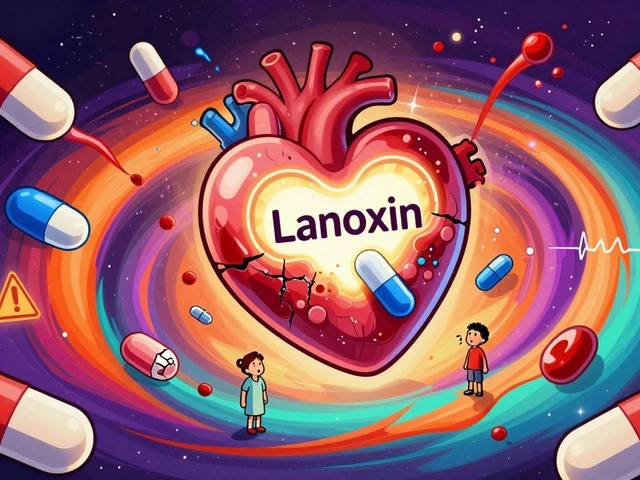Lamotrigine Comparison: How It Measures Up Against Other Antiseizure Drugs
When working with Lamotrigine, an anticonvulsant used for epilepsy and bipolar disorder. Also known as Lamictal, it helps control seizures and mood swings by stabilizing neuronal firing. In practice, Valproate, a broad‑spectrum seizure medication and Levetiracetam, a newer agent with a different mechanism are the most common comparators. Understanding how Lamotrigine compares to these drugs lets patients and clinicians pick the right balance of efficacy, safety, and cost.
First, let’s talk efficacy. Studies show Lamotrigine reduces the frequency of focal seizures by about 30‑40% when given at therapeutic doses, while Valproate often hits a slightly higher reduction (35‑45%) but brings more weight‑gain concerns. Levetiracetam, on the other hand, can match or exceed Lamotrigine’s seizure control in many patients, especially those with generalized epilepsy. The Lamotrigine comparison therefore hinges on whether you prioritize broad seizure coverage (Valproate), minimal side‑effects (Lamotrigine), or rapid titration (Levetiracetam).
Side‑effect profiles are another decisive factor. Lamotrigine is famous for a potentially serious rash, including Stevens‑Johnson syndrome, which forces a slow titration schedule. Valproate tends to cause hair loss, tremor, and liver enzyme elevation, making it less attractive for long‑term use in young adults. Levetiracetam often leads to irritability or behavioral changes, which can be problematic for patients with mood disorders. By mapping these risks, the Lamotrigine comparison reveals a trade‑off: a slower start for a cleaner long‑term side‑effect picture versus faster onset but higher rates of irritability or metabolic issues.
Practical Considerations When Choosing Between Them
Cost and accessibility also shape the decision. Generic Lamotrigine tablets are typically cheaper than brand‑name Lamictal, yet still pricier than generic Levetiracetam in many markets. Valproate remains one of the most affordable antiseizure drugs, which explains its continued popularity in low‑resource settings. Online pharmacy guides often teach users how to verify legitimate sellers and avoid counterfeit versions—knowledge that matters for any of these three meds.
Dosage flexibility matters, too. Lamotrigine requires a gradual increase over weeks to reach a maintenance dose of 100‑200 mg daily, depending on age and co‑medications. Valproate can be started at a higher dose (usually 10‑15 mg/kg) and reached quickly, while Levetiracetam’s titration is straightforward—a simple 500 mg twice‑daily regimen that many patients tolerate well. This dosage dynamic directly influences the Lamotrigine comparison: if a patient needs rapid seizure control, Valproate or Levetiracetam may be favored; if they can wait and want fewer systemic effects, Lamotrigine wins.
Drug interactions are a third pillar of the comparison. Lamotrigine’s metabolism via glucuronidation means it can be affected by enzyme‑inducing drugs like carbamazepine, which can cut its levels by up to 50 %. Valproate, conversely, inhibits glucuronidation, raising Lamotrigine levels and increasing rash risk—so co‑prescribing demands careful monitoring. Levetiracetam has the cleanest interaction profile, making it a safe add‑on for patients already on multiple psychotropics. Knowing these interaction pathways helps clinicians avoid dangerous combos and choose the safest partner drug.
From a patient‑centred view, the Lamotrigine comparison also includes quality‑of‑life outcomes. Many surveys report that patients on Lamotrigine experience fewer cognitive side‑effects compared with Valproate, which can cause sluggishness and memory fog. Levetiracetam’s behavioral side‑effects can impact daily functioning, especially in adolescents. Therefore, when the goal is to maintain mental sharpness and mood stability, Lamotrigine often comes out ahead, despite the slower titration.
Finally, regulatory status and prescribing guidelines shape the landscape. In most countries, Lamotrigine is listed as a first‑line agent for focal seizures and as a maintenance therapy for bipolar II disorder. Valproate is discouraged in women of childbearing age due to teratogenic risk, while Levetiracetam is approved for a wide age range and is increasingly recommended for patients who cannot tolerate older drugs. This regulatory context adds another layer to the Lamotrigine comparison, highlighting scenarios where alternative drugs are either preferred or avoided.
All these angles—efficacy, side‑effects, cost, dosage, interactions, quality of life, and guidelines—create a multi‑dimensional picture of how Lamotrigine stacks up against its peers. Below you’ll find a curated list of articles that dive deeper into each of these topics, from detailed side‑effect tables to step‑by‑step buying guides. Use them to fine‑tune your treatment plan, compare prices safely, and get practical tips for managing any switching process.
Lamictal vs. Other Mood Stabilizers: Detailed Comparison of Lamotrigine and Its Alternatives
A thorough comparison of Lamictal (lamotrigine) with top mood‑stabilizer alternatives, covering mechanisms, side effects, cost, and practical switching tips.





